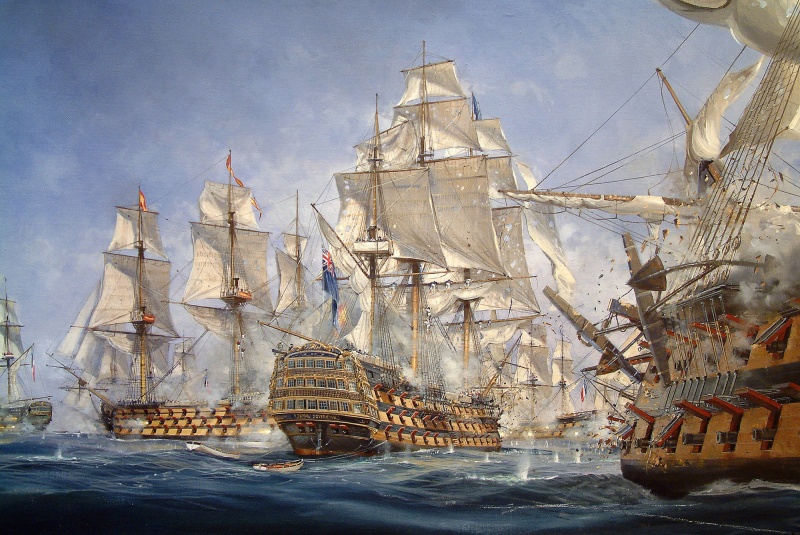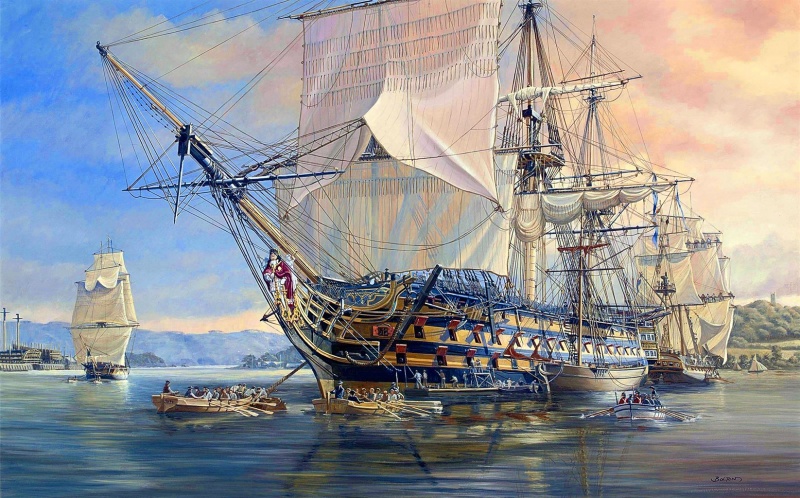HMS Royal Sovereign (1786).
. . HMS Royal Sovereign was ordered by the British government on February 3rd, 1786 and constructed by Plymouth Dockyard in Plymouth, her keel being laid down on January 7th, 1774. She was officially put out to sea on September 11th, 1786.
As built, HMS Royal Sovereign was given a running length of 183 feet, 10.5 inches with a beam measuring 52 feet and a draught of 22 feet, 2.5 inches. She was a three-masted, fully-rigged vessel with each mast carrying a name for quick identification purposes - the first in line being the foremast, the central perch becoming the mainmast and the aft post the mizzenmast. To this were added individual names to each sail fitting, from the moonmast and staysail, the royal and topgallant and, finally, to the topsail and forecourse. Forward sail spans (those running from the foremast to the jibboom - the post protruding from the bow over the figurehead at the "beak" of the ship) were identified as the flying jib, outer jib, inner jib and fore topmast staysail. At the stern there resided the "spunker", also recognized as the "driver". Wind powered ships of the period making use of an underwater rudder critical in maneuvering. The captain's cabin was situated at the upper stern of the ship with crew quarters, gundecks and stores about the hull of the ship. Various lines and netting were affixed from the masts to the deck to allow the crew to climb the rigging and masts as well as management of the sails in general.
History UK Name: HMS Royal Sovereign Ordered: 3 February 1786 Builder: Plymouth Dockyard Laid down: 7 January 1774 Launched: 11 September 1786 Renamed: HMS Captain, 17 August 1825 Honours and
awards:Participated in:
Fate: Broken up, 1841 Notes: Harbour service from 1826 General characteristics Class and type: 100-gun first rate ship of the line Tons burthen: 2175 (bm) Length: 183 ft 10 1⁄2 in (56.0 m) (gundeck) Beam: 52 ft 1 in (15.88 m) Depth of hold: 22 ft 2 1⁄2 in (6.8 m) Propulsion: Sails Sail plan: Full rigged ship Armament:
HMS Royal Sovereign served the British Royal Navy during the latter portion of the 18th Century and the early portion of the 19th Century and is famously remembered for her participation (alongisde Horatio Nelson's HMS Victory) in the Battle of Trafalgar- a decisive British naval victory over the combined French-Spanish fleet.
The day after Trafalgar, the Victory under canvas endeavouring to clear the land, the Royal Sovereign disabled and in tow by the Euryalus, in the collection of the National Maritime Museum; Nicholas Pocock; 19th century
The vessel was termed a "100-gun first-rate, ship-of-the-line" which not only identified her armament but also her fighting qualities within the British fleet. First rate ships typically were fielded with 100 guns or more and these were then followed by second-, third- and forth-rate ships with fewer guns. A well-experienced naval tactician would then use his fleet by observing enemy maneuvers and positioning his warships as required to deliver lethal broadsides. As all armament was set to fire from the port and starboard sides of the warship, broadsides were the attack of choice, essentially one ship moving into parallel position with his target and firing all guns.
Not the fastest or most mobile of the fleet, the Royal Sovereign none-the-less packed a punch. At its core, the vessel was a fighting ship and, as such, granted a collection of 100 guns across three main decks (identified along her sides by numerous gunports. There was the primary gundeck armed with 28 x 32-pounder cannon, the middle gundeck with 28 x 24-pounder cannon and the upper gundeck with 30 x 12-pounder cannon. 10 x 12-pounders were added to the quarterdeck while the forecastle carried an additional 4 x 12-pounders.
One of Royal Sovereign's first notable actions occurred on June 1st, 1794 when the British fleet under Lord Howe faced off against the French and Villaret-Joyeuse. The Royal Navy met with 25 ships-of-the-line versus France's 26. The battle became known as the "Glorious First of June" and the "Third Battle of Ushant" and occurred during the French Revolution, which included several wars fought from 1792 into 1802.The battle took place west of the French hold of Ushant in the Atlantic and ended in a British tactical victory while also representing a French strategic victory. Casualties included 1,200 Royal Navy personnel against 4,000 French of which a further 3,000 were taken prisoner. The French Navy also lost as many as seven warships. The Royal Sovereign lost 14 souls and saw a further 41 wounded.
Royal Sovereign's next notable action occurred during the span of June 16th-17th, 1795 in what was termed "Cornwallis's Retreat". This engagement was also undertaken during the French Revolutionary War period and consisted of a defending action on the part of the British, five ships-of-the-line staring across at twelve enemy ships-of-the-line along with eleven frigate type vessels (the French commanded by Admiral Villaret de Joyeuse). The combat took place off the coast of Brittany in the Atlantic ocean with the French ultimately failing to break the British defense under Vice-Admiral William Cornwallis. French-British engagements did not end there for they only set the stage of the most famous Royal Navy sea battle of them all - the Battle of Trafalgar.
The Battle of Trafalgar took place on October 21st, 1805 off the coast of Cape Trafalgar, Spain (near the Strait of Gibraltar) the vessel fell under the command of Vice-Admiral Cuthbert Collingwood while Admiral Horatio Nelson headed HMS Victory. They faced off against a combined French-Spanish force led by Admiral Pierre-Charles Villeneuve and Admiral Federico Gravina repectively. Numbers included 33 Royal Navy ships versus 41 of the enemy fleet. The British managed 27 ships-of-the-line versus 18 fielded by the French Navy and 15 by the Spanish.
By this time, French leader Napoleon Bonaparte had amassed an army at Boulogne designed to invade Britain proper. However, his troop barges were unarmed and would be ripe for the taking under the guns of the vaunted British fleet. As such, he commissioned Admiral Villeneuve to form the French fleet and destroy the British warships. A contingent of Spanish would also assist. Villeneuve formed approximately 50% of available French naval power to meet Napoleon's deadline and rendezvoused with the Spanish off the coast of Cadiz before sailing out to meet the British on October 19th, 1805.

Royal Sovereign - First Through The Line By Richard Grenville, Battle of Trafalgar
Under Nelson's orders and going by a well-planned attack route, the British plunged into the action to limit the French-Spanish response. HMS Royal Sovereign engaged the Spanish ship Santa Ana to which the vessels both took on damage in the fray as lines of ships delivered broadsides in passing. Royal Sovereign lost her mainmasts, mizzen and rigging, losing much control and ordered towed away from the action (by this time Nelson had been reported injured to Collingwood). Coming under attack during the rescue, tow lines to HMS Royal Sovereign from HMS Euralus - a 36-gun frigate - were severed. Royal Sovereign was saved for the interim by a collection of British ships rallying together near her to help fight off the incoming enemy. Saved, though barely afloat, the Royal Sovereign was barely able to respond and of little tactical use. A second rescue action on the British ship was moot and Collingwood then boarded the arriving Euryalus who had, once again, been attempting to run lines to the Royal Sovereign.
The battle was now over with the enemy fleet in defeat, Nelson lay dead (killed by a sniper during the commotion) and Collingwood assuming command. Royal Sovereign casualties numbered 141 while the vessel itself was recovered and salvaged. With the battle over, the British claimed a decisive victory at sea at the total expense of 458 dead and 1,208 wounded. The enemy fleet suffered 13,781 casualties including 2,218 Frenchmen dead and 1,025 Spaniards. 10 French ships were captured along with 11 Spanish vessels with, amazingly, no loss of ships dealt to the British (only five of the enemy ships would ever be put into action again). Additionally, 4,000 persons were taken prisoner while some 3,000 drowned after the battle had ended. Villeneuve was taken prisoner by the British while Gravina, though escaping the barrel wounded, died a few months later. The battle became one of Britain's most revered naval engagements and made Horatio Nelson a household name.
Key to the victory was Nelson's use of a two-column approach against a numerically larger foe. Doctrine of the day called for a single-line pattern approach to make the most of the broadsides and keep the chain of communications open during the confusion. Nelson's direction allowed for his outnumbered fleet to handle the French Navy one of its worst losses and keep British supremacy of the sea intact, this through combining confusion and limited maneuverability of the enemy while falling to the guns of British firepower. The battle lasted for approximately 4.5 hours, having begun at 12PM and ended around 4:30PM.

Stuart Bolton, Century , H. Royal Sovereign emerging from her refit and lying in the Hamoaze, Plymouth Sound
HMS Royal Sovereign was docked for an extended period while undergoing repairs. She was set out to sea once more in 1806 and this time toured the Mediterranean Sea. She participated in the naval blockade action of Toulon against France where she stayed on station into November of 1811. After this period, she was called back to England and joined the Channel Fleet in defense of the English Channel. The Channel Fleet held a long-running history, formed in 1690 and managed to defend the critical English waterway until 1909 with ships based out of Plymouth, Falmouth and Torbay.
Once her fighting days were deemed behind her, HMS Royal Sovereign underwent a period of modification which saw her begin life anew on August 17th, 1825 as a harbor service craft named HMS Captain. Her tenure as the Captain did not last long for, in June of 1926, the vessel was pulled from service and broken up for scrap at the Plymouth shipyard with only four cannon claimed as memorial showpieces (the Collingwood Memorial, Tynemouth). This process would last until August of 1841 before history brought an end to the long-lasting career of HMS Royal Sovereign.
Collingwood, now Admiral, died on March 7th, 1810 at the age of 61 aboard HMS Ville de Paris while on duty (as Commander-in-Chief) in the Mediterranean Sea. He was sailing home due to poor health. Collingwood is buried alongside Nelson at St Paul's Cathedral in London.
From 1826 onwards, the Royal Sovereign was relegated to a period of harbor service before being broken up in 1841, bringing an end to her long-lasting carrier on the high seas.








Bookmarks